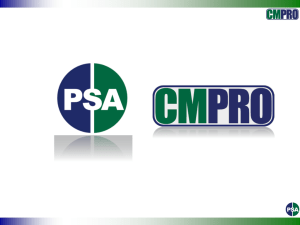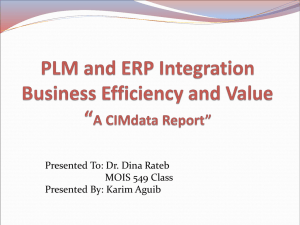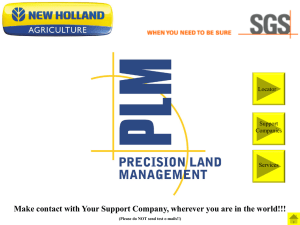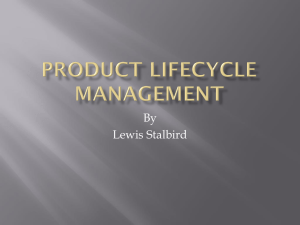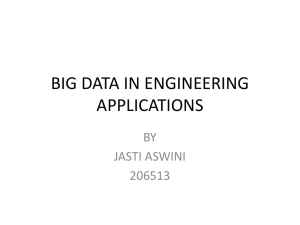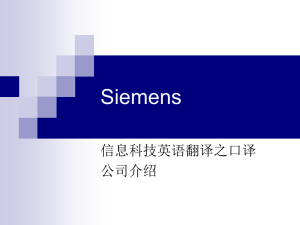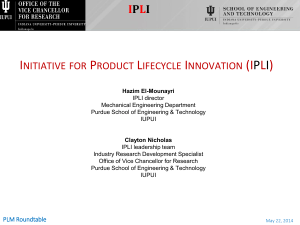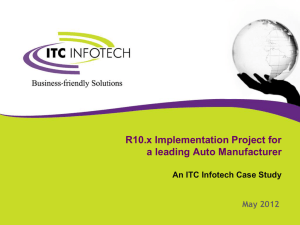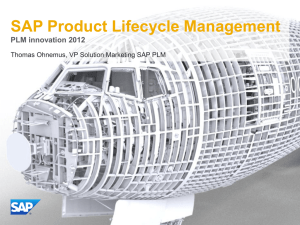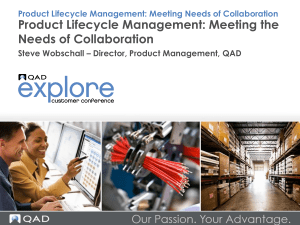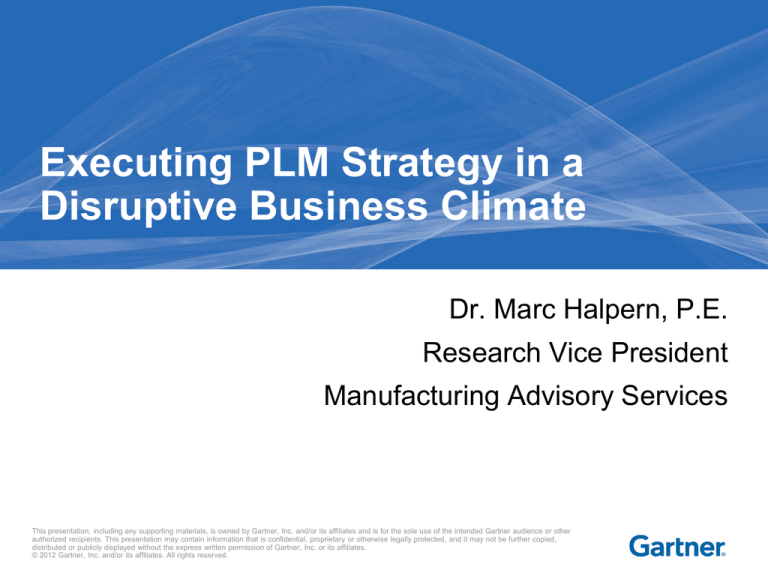
Executing PLM Strategy in a
Disruptive Business Climate
Dr. Marc Halpern, P.E.
Research Vice President
Manufacturing Advisory Services
This presentation, including any supporting materials, is owned by Gartner, Inc. and/or its affiliates and is for the sole use of the intended Gartner audience or other
authorized recipients. This presentation may contain information that is confidential, proprietary or otherwise legally protected, and it may not be further copied,
distributed or publicly displayed without the express written permission of Gartner, Inc. or its affiliates.
© 2012 Gartner, Inc. and/or its affiliates. All rights reserved.
Global Volatility Demands Greater Product
Lifecycle Management Focus
Changing Market
Demographics
Environmental
Stress
Disruptive Technology
Source: Baker, Bloom and Davis (2011)n(voxeu.org)
Economic Uncertainty
1
Key Topics
• What five business trends show greatest promise
to address today’s challenges?
• How is Product Lifecycle Management (PLM)
evolving to support the emerging business trends?
• Which priorities and practices enable the greatest
chance for successful PLM implementations?
2
Key Topics
• What five business trends show greatest promise
to address today’s challenges?
• How is Product Lifecycle Management (PLM)
evolving to support the emerging business trends?
• Which priorities and practices enable the greatest
chance for successful PLM implementations?
3
1. Incorporate Software to Deliver the
Value of Manufactured Products
Processors on
Wheels
Physical Software
Hybrids
Soft Products
• 10 million lines of code
• 50 ECUs
• 30,000 calibration parameters
• Four or more vehicle BUS
systems
• Virtualized physical
products
• Software replaces
mechanical HMIs
• Electromechanical
human-machine interfaces
• Unlimited virtual
products on PCs and
mobile devices
2. Employ Social Media to Accelerate
Product Innovation – Networked Cocreation
3. Leverage Product Life Cycle Analytics to
Continuously Learn and Improve Brand Value
Customers
pleased?
On time?
On budget?
Meeting
specs?
Revenue as
expected?
Quality
targets
met?
Ideation Concept Detailed Production Ramp-up Service/
Design
Design
Support
Retire Postretire
Phases
4. Identify Opportunities for Products as
Services to Produce New Revenue Streams
Entertainment
Tapes and DVDs
Video streaming
Automotive
Car auction
Zipcar renting
Recreation
Buying books
E-readers
5. Implement Manufacturing 2.0 to Become
More Agile and Fulfill Local Market Needs
Degree of Contract Manufacturing
Rate of NPDI
Global Coordination
Dynamic
Multitier
Collaboration
Manufacturing 2.0
Manufacturing SOA Supporting:
Multiple Manufacturing Styles
Demand-Driven Manufacturing
Multienterprise Collaboration
Orchestration of Multivendor Services
User-Centric Interface
User Implementation
Mobile Workforce
Sensor Networks
Dynamic
Supply
Single-Tier
Network Collaboration
Dynamism
Static
Internal
Collaboration
Manufacturing
1.0
(MES) Multisite MES
MTS
Single-Site
(Owned)
Local Execution
ATO/ETO
Multisite
(Owned)
Product/Manufacturing Complexity
Multisite
(Owned and
Contracted)
Product Mix
Number of Manufacturing
Styles
Key Topics
• What five business trends show greatest promise
to address today’s challenges?
• How is Product Lifecycle Management (PLM)
evolving to support the emerging business trends?
• Which priorities and practices enable the greatest
chance for successful PLM implementations?
9
PLM is More About Discipline, Process,
and Culture Than Software
PLM is a discipline for guiding products
and product portfolios from ideas through
retirement to create the most value for
businesses, their partners, and their customers
PLM Addresses Product Costs and Revenue
Cost-Reduction Enablers
Revenue Growth Enablers
COST CATEGORIES PLM SCM CRM ERP MES
OPPORTUNITIES PLM SCM CRM ERP MES
Material/part selection
Identify New Selling Opps
Production planning
Differentiate Products
Manufacturing Operations
Diversify Product Sets
Selling
Access New Markets
Service
Increase Capacity
Greatest Impact
Notable Impact / Supporting Role
Lower or no Impact
PLM – Addressing the Global-Value Chain
Design
Define
Post-Retire
Retire
Strategy
Supply
Governance
Manufacture
Content Capture,
Control, & Reuse
Ramp-up
Service &
Support
Market
Value
Product Portfolios
Profitable
Supply
Customer Needs
Demand
Insights
Demand
Data
Materials Sourcing
Product-Process Design
Product IP and Data Mgmt.
12
Supply
Network
Supply
Data
Mapping Some Enabling PLM Application
Classes to Five Business Trends
#
Business Trend
Some related PLM and
MES Software apps.
Key Elements of IT
Foundation
1
Embedded Software
systems engineering,
requirements mgmt., virtual
prototyping, simulation and test
data mgmt.
software development
environment, enterprise
application integration
2
Networked Co-creation
PLM/Mfg. cloud computing,
neutral CAx formats, PDM
Social networking, Collaboration
software, enterprise content
mgmt., portals
3
Continuous
Improvement
customer needs mgmt., process
analytical tech., quality mgmt.
systems, LIMS, sustainable
design, PDM, product cost
mgmt.
BI/analytics technology,
enterprise asset mgmt.,
enterprise content mgmt., search,
data warehouse
4
Products as Services
systems engineering,
requirements mgmt., virtual
prototyping, simulation and test
data mgmt.
ERP, CRM, software
development and validation
environment, web application
servers
5
Manufacturing 2.0
Operations intelligence,
synchronized BOMs, MPM
framework, EAM
service-oriented architecture,
enterprise asset mgmt., 2-Tier
ERP
13
Hype Cycle for Manufacturing Product Life
Cycle Management and Production, 2011
expectations
System Engineering Software
Operations Intelligence
SOA in Manufacturing
MRO PLM Functionality
Manufacturing Process
Management Framework
Energy Management in Manufacturing
Sustainable Design PLM
Asset Performance Management
Product Cost Management
Modeling, Simulation and Virtual Prototyping
Synchronized Bills of Materials
IT/OT Convergence in Manufacturing
Two-Tier ERP Strategy for
Manufacturing Operations
Customer
Needs
Management
Cloud Computing in PLM
and Manufacturing
MES Applications
CAD-Centric Design
Enterprise Manufacturing
Data Management
Intelligence
Process Analytical
Process Data Historians
Technology
Manufacturing
Process Validation
Regulatory Compliance
Functionality Within
PLM
ISA-95 Integration
Standards
Virtual Factories
Enterprise Asset Management
Value-Chain-Centric PDM
PLM-Centric Team Collaboration
Parts and Materials Search and Selection
Formula/Recipe Management
Factory Scheduling
Product Portfolio and Program Management
Quality Management Systems
LIMS
Simulation and Test Data Management
EH&S Applications
Technology
Trigger
Peak of
Inflated
Expectations
Trough of
Disillusionment
Slope of Enlightenment
As of July 2011
Plateau of
Productivity
time
Years to mainstream adoption:
less than 2 years
2 to 5 years
5 to 10 years
more than 10 years
obsolete
before plateau
PLM Market Dynamics
Scope
Oracle
Corporate and
Back Office
SAP
Aras, Selerant, Sopheon,
other specialty PLM
vendors,
Microsoft
Dassault Systemes,
PTC
Siemens
New Product
Development
Autodesk
Scale
Small Enterprise
Large Enterprise
Key Topics
• What five business trends show greatest promise
to address today’s challenges?
• How is Product Lifecycle Management (PLM)
evolving to support the emerging business trends?
• Which priorities and practices enable the greatest
chance for successful PLM implementations?
16
Gartner Survey Shows Manufacturers
Invest Big in PLM Software and Services
Industry Participation
Others
11%
Aerospace
and
Defense
10%
($ Millions)
Consumer
Goods
31%
High Tech
14%
Automotive
16%
Estimated Spending on PLM
Software per Deployment
Machinery
18%
62 Participating
Companies
Industry
50% of deployments Minimum spending
spent at least
reported
Consumer
Goods
$2.4 million
$300,000
Machinery
$2.7 million
$500,000
Automotive
$7.2 million
$1 million
High Tech
$3.2 million
$100,000
Aero & Defense
$2.3 million
$300,000
Others
$2.7 million
$200,000
Best Practice PLM Deployments
No.
Best Practice
Manufacturer
Benefits Achieved
1
Focus on building business
capability at the mindset layer
U.S.-based healthcare
manufacturer
More systematic team-centric NPD
processes with less dependence on
skilled individuals
2
Mind-set layer of "macro" level
elements
International beverage
company
Instituted phase-gate process, yielding
major quality advances
3
Evangelize the "configuration"
mind set broadly
Parts and equipment
supplier
Removed redundancy from product
portfolio accelerated growth
4
Don't outsource configurational
thinking
Parts and equipment
supplier
Clear corporate thought leadership
cultivated greater global cooperation
5
Triangular governance for IT
implementation activities
Apparel and footwear
company
Streamlined NPD processes yields
shorter time to market
6
Engage suppliers in the PLM
business transformation
European machinery
manufacturer
Reduced incompatible and redundant
product data improved NPD
collaboration
7
Continue configurational thinking
during change management
U.S.-based healthcare
manufacturer
Helped institutionalize processes for
capturing and reusing produce content
This research was conducted in collaboration with Satish Nambisan, Lally School of Management, Rensselaer Polytechnic
Institute and Robert G. Fichman Carroll School of Management ,Boston College
Five Top Suggestions for Manufacturers of
Products with Embedded Software
1. Use marketing intelligence, requirements analysis,
and systems engineering to define products
2. Prioritize supply chain collaboration for software
development and compatibility
3. Plan for software demands that are appropriate for
product service life
4. Start software development earlier in the product
development cycle
5. Enable software development tools as part of value
chain PLM SW application stack.
Five Top Suggestions for Manufacturers
of Recipe/Formula-based Products
1. Use marketing intelligence and “formulation
architecture” to define products
2. Managing specifications should be the backbone that
links production planning with product development
3. Prioritize supply chain collaboration for raw material
quality and traceability
4. Invest in infrastructure that streamlines variant
artwork and packaging for variant formulas/recipes
5. Use PLM to harmonize “equivalent items” in diverse
material masters when multiple ERPs are active
20
Summary
• What five business trends show greatest promise
to address today’s challenges?
• 1) SW delivers product function, 2) Social networking supports
innovation, 3) Business intelligence to improve continuously,
4) products as services, 5) manufacturing 2.0
• How is Product Lifecycle Management (PLM)
evolving to support the emerging business trends?
• Enterprise centric to value-chain centric, increasingly systems
centric, greater accessibility through standards and “the cloud.”
• Which priorities and practices enable the greatest
chance for successful PLM implementations?
• Align PLM and job performance metrics to business goals, engage
business leaders, business operations, and IT, Configurational
thinking across business and technical priorities
21
Gracias!
!תודה
Grazie!
email: marc.halpern@gartner.com
phone: 1-203-316-6894
22
Tack!

